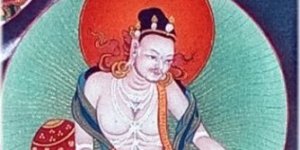| Library / Spiritual Traditions |
Sakya Tradition
The Sakya tradition is one of four major schools of Tibetan Buddhism, the others being the Nyingma, Kagyu, and Gelug. It is one of the Red Hat Orders along with the Nyingma and Kagyu.
The name Sakya ("pale earth") derives from the unique grey landscape of the Ponpori Hills in southern Tibet near Shigatse, where Sakya Monastery, the first monastery of this tradition, and the seat of the Sakya School was built by Khon Konchog Gyalpo (1034–1102) in 1073.
History
The Sakya school has its origins in the ancient Khön family of Tibet. Khön Luyi Wangpo was a disciple of Guru Rinpoche and one of the first seven Tibetan monks, the so called 'seven men to be tested'. Several generations later, in 1073, his descendant Khön Könchok Gyalpo founded the monastery of Sakya in Tsang province.

Sachen Kunga NyingpoThe Sakya tradition was established and spread by five great masters, the 'Sakya Gongma Nam Nga': Sachen Kunga Nyingpo (1092-1158), his two sons Sönam Tsemo (1142-1182) and Drakpa Gyaltsen (1147-1216), his grandson Sakya Pandita (1182-1251) and the latter's nephew Chögyal Pakpa (1235-1280).
Buton Rinchen Drub (1290–1364) was an important scholar and writer and one of Tibet's most celebrated historians.
Other notable scholars of the Sakya tradition are the so-called "Six Ornaments of Tibet:" Yaktuk Sangyey Pal, Rongton (1367–1449), Ngorchen Kunga Zangpo, Zongpa Kunga Namgyel, Gorampa (1429–1489) and Sakya Chokden (1428–1507).
The Sakya lamas attracted the patronage of the Mongol emperors of China, and in 1253 Kublai Khan conferred the rulership of the whole of Tibet upon his teacher, Chögyal Pakpa.
This political ascendancy of Sakya lasted about a century, but Sakya itself remained an autonomous principality.
During the fourteenth century, Tishri Kunga Lodrö Gyaltsen (1299-1327), eldest grandson of Sakya Pandita’s brother, established four dynastic houses (Tib. labrang): Shyithok, Rinchen Gang, Lhakhang, and Düchö. Only the Düchö Labrang remains to this day.
During the eighteenth century, the Düchö Labrang was split into two ‘cousin’ palaces, by 32nd Sakya Trizin Jamgön Wangdü Nyingpo.
The leadership of the Sakya School is passed down through a hereditary system between the male members of the Sakya branch of the Khon family. The leadership in the Khön Family and the throne holders of the Sakya school have alternated between the Drolma and Phuntsok Podrangs.
Teachings
Sachen, the first of the five supreme masters, inherited a wealth of tantric doctrines from numerous Tibetan translators or "lotsawas" who had visited India: most importantly Drokmi Lotsawa, Bari Lotsawa and Mal Lotsawa.
From Drokmi comes the supreme teaching of Sakya, the system of Lamdre "Path and its Fruit" deriving from the mahasiddha Virūpa based upon the Hevajra Tantra.
From Bari Lotsawa came innumerable tantric practices, foremost of which was the cycle of practices known as the One Hundred Sadhanas. Other key transmissions that form part of the Sakya spiritual curriculum include the cycles of Vajrakilaya, Mahākāla and Guhyasamāja tantras.
Mal Lotsawa introduced to Sakya the esoteric Vajrayogini lineage known as "Naro Khachoma."
The fourth Sakya patriarch, Sakya Pandita, was notable for his exceptional scholarship and composed many important and influential texts on sutra and tantra, including "Means of Valid Cognition: A Treasury of Reasoning", "Clarifying the Sage's Intent" and "Discriminating the Three Vows".
The main Dharma system of the Sakya school is the "Path with its Result", which is split into two main lineages, "Explanation for the Assembly" and the "Explanation for Close Disciples".
The other major system of the Sakya school is the "Naropa Explanation for Disciples".
Another important series of teachings is based on verses of Günga Nyingpo (1092–1158) called "separating from the four attachments" which is the subject of commentaries by numerous Sakya masters like Drakpa Gyeltsen, Sakya Pandita, Ngorchen Günga Sangpo, and Gorampa Sönam Senggé.
Subschools

Sakya Monastery, Tibet.The two main subschools are:
• Ngor, founded by Ngorchen Kunga Zangpo (1382-1456). It is characterized by its rigorous discipline and knowledge of the tantras. Luding Khen Rinpoche, one of the sons of Jetsün Kushok Chimey Luding, is the present head of this school.
• Tsar, founded by Tsarchen Losal Gyatso (1502-1566). The Tsar lineage is renowned for its teachings on the greater and lesser Mahakala, and the transmissions of ‘Thirteen Golden Dharmas’. Its main monastery in Tibet was Dar Drangmoche Monastery in Tsang, and now in exile Tashi Rabten Ling at Lumbini, along with two other monasteries in Kathmandu, Nepal that represent the Tsar lineage. His Eminence Chogye Trichen Rinpoche who passed away in 2007 was the head of the Tsar lineage.
Other subschools:
• The Dzongpa tradition founded by Dzongpa Kunga Namgyal (1432-1496.)
Sakya Masters
Dampa Sönam Gyaltsen
Writings: Clear Mirror on Royal Genealogy; Commentaries on Bodhisattvacaryāvatāra, Pramāṇavārttika, Abhisamayalankara, and Nagarjuna's treatises.
Disciples: Rendawa Zhonnu Lodro (1349-1412); Tsongkhapa Lobzang Drakpa (1357-1419); Longchenpa Rabjam Drime Ozer (1308-1364).
Sakya Lineage

Sources
• https://en.wikipedia.org/wiki/Sakya
• https://www.rigpawiki.org/index.php?title=Sakya
• http://xuanfa.net/
YOU MAY ALSO LIKE





